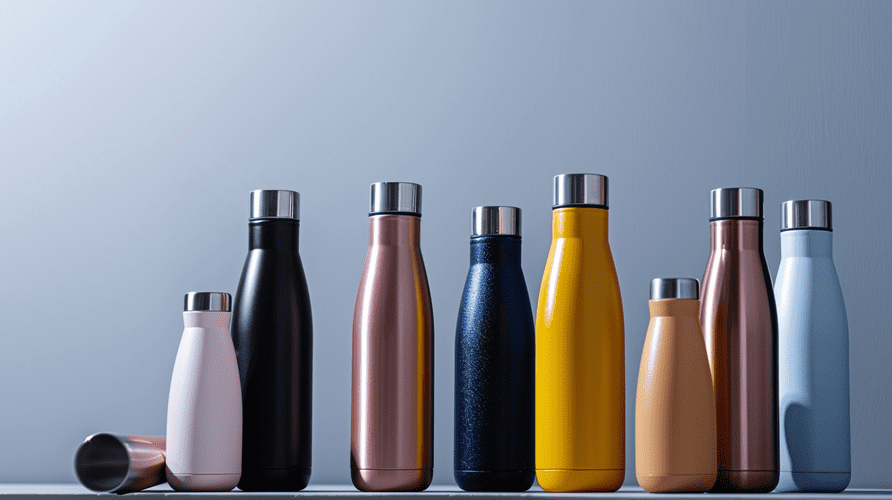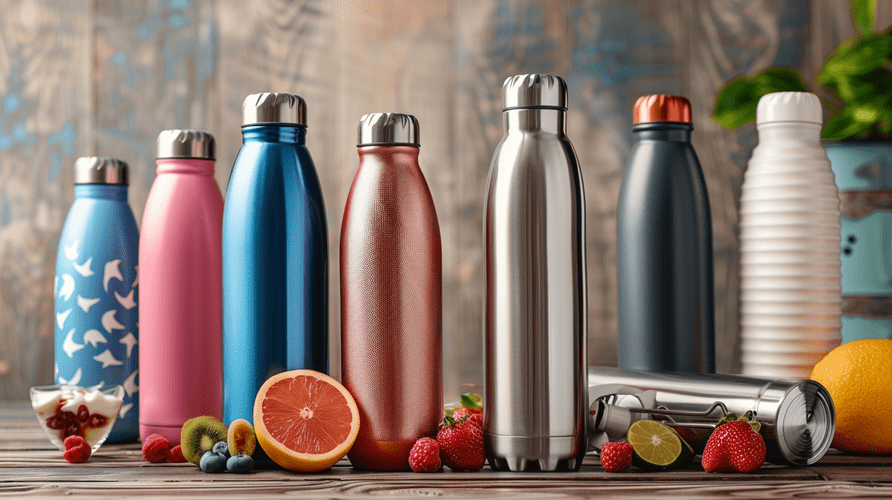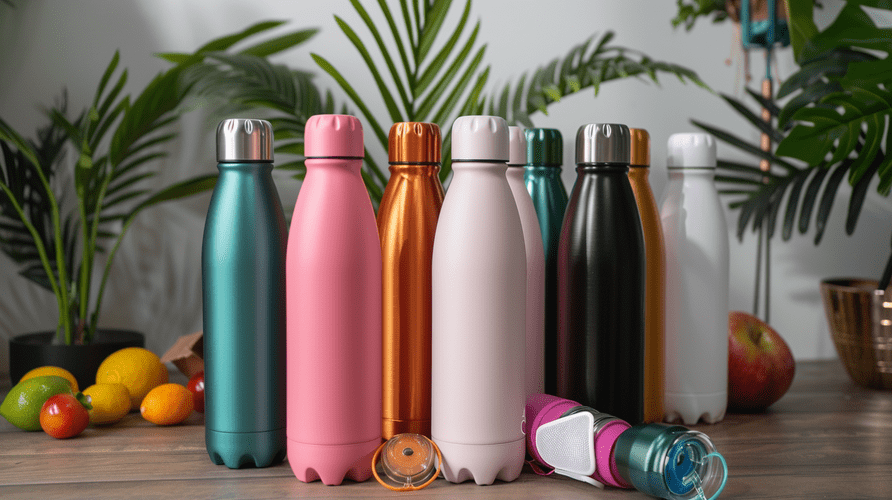Does your insulated bottle smell strange? Worried about germs or bad taste? Regular cleaning keeps your high-quality bottle fresh, safe, and lasting longer for your customers.
Clean your insulated bottle daily with warm soapy water. For deeper cleaning or odors, use vinegar or baking soda. Proper care ensures longevity and prevents unpleasant tastes or bacteria buildup.

Keeping your bottle clean is the first step. But sometimes specific issues come up. As a manufacturer, I often get questions about these details from clients like Mark, who need reliable products for their own brands. Let's look at some common questions.
How to remove metallic taste from stainless steel water bottle?
Does your new stainless steel bottle have a metallic taste? It can ruin your drink and make you question the quality. Luckily, simple cleaning steps often remove this taste effectively.
Remove metallic taste1 by washing with vinegar and water (1:1 ratio) or a paste of baking soda and water. Let it sit for a few minutes or hours, then rinse thoroughly. This usually neutralizes the taste.

Dive Deeper: Understanding and Eliminating Metallic Taste
That metallic taste, especially in a new bottle, can be off-putting. Let's break down why it happens and how to fix it for good.
Why Does a New Bottle Sometimes Taste Metallic?
Most quality stainless steel bottles2, like the ones we produce at Icobottle using food-grade 304 (18/8) stainless steel, are very safe and shouldn't leach harmful chemicals. The metallic taste usually comes from a couple of sources:
- Manufacturing Residues: Tiny particles or polishing compounds might remain from the production process. These are generally harmless but can affect the taste initially. A thorough first wash usually removes them.
- Passivation Layer: Stainless steel has a natural protective layer (chromium oxide). Sometimes, especially when new, this layer interacts slightly with water, causing a faint metallic taste. This typically fades with use and washing.
- Water Source: Occasionally, the metallic taste might come from your tap water itself, which has high mineral content, rather than the bottle.
It's very rare for the steel itself to be the problem if it's high-quality food-grade material. Issues are more likely with very cheap, non-certified bottles where the material quality might be questionable.
Step-by-Step: Removing the Metallic Taste
Here are two effective methods I recommend:
-
Using White Vinegar:
- Fill the bottle about one-fifth full with white vinegar.
- Fill the rest with warm water.
- Close the lid and shake gently.
- Let it sit for a few hours or overnight for stubborn tastes.
- Empty the bottle and rinse it very thoroughly with warm water multiple times to remove any vinegar smell or taste.
- Wash again with regular dish soap and water.
-
Using Baking Soda:
- Put one or two teaspoons of baking soda into the empty bottle.
- Fill it with warm water.
- Stir or shake well to dissolve the baking soda.
- Let it sit for at least an hour, or longer if needed.
- Rinse thoroughly with warm water until all traces of baking soda are gone.
- Wash with dish soap and water as a final step.
These methods are safe for stainless steel and usually very effective. For business customers like Mark, ensuring end-users know these simple tips can prevent unnecessary complaints about product quality.
How often do you need to replace an insulated water bottle?
Wondering if your trusty insulated bottle lasts forever? Using a worn-out bottle isn't ideal for performance or hygiene. Knowing when to replace it ensures you get the best experience.
A quality insulated bottle can last for many years with proper care. Replace it if the insulation fails (doesn't keep drinks hot/cold), it's visibly damaged (cracks, rust, deep dents affecting the seal), or it's impossible to clean thoroughly.

Dive Deeper: Lifespan and Replacement Signs for Insulated Bottles
Insulated water bottles are durable, but they don't last forever. As someone who supplies these products wholesale, I know buyers like Mark need reliable items that offer good value and longevity for their customers. Understanding the lifespan helps manage expectations.
What Shortens an Insulated Bottle's Life?
Several factors can affect how long your bottle performs well:
- Physical Damage: Drops are the biggest enemy. A significant dent, especially near the bottom or top rim, can break the vacuum seal that provides insulation. Cracks, even small ones, compromise the structure and hygiene.
- Wear and Tear on Seals: The silicone or rubber gaskets in the lid are crucial for preventing leaks and maintaining temperature. Over time, these can stretch, crack, dry out, or accumulate mold that's hard to remove.
- Internal Scratches: Using harsh abrasive cleaners or metal utensils inside the bottle can scratch the stainless steel surface. While generally cosmetic, deep scratches can potentially harbor bacteria and become harder to clean properly.
- Poor Cleaning Habits: Allowing residue to build up or not drying the bottle properly can lead to persistent odors, stains, or even mold growth, making the bottle unpleasant or unsafe to use.
Key Signs You Need a New Bottle
Watch out for these indicators:
| Sign | Description | Why Replace? |
|---|---|---|
| Loss of Insulation | Bottle exterior feels hot with hot liquids, or cold/sweaty with cold ones. | The vacuum seal is broken; it's no longer insulated. |
| Visible Damage | Cracks, significant dents affecting shape, rust spots (rare on quality steel). | Compromises structure, hygiene, or insulation. |
| Persistent Odors/Stains | Smells or discoloration won't go away despite deep cleaning attempts. | Unpleasant to use, may indicate hidden mold/residue. |
| Damaged/Leaky Lid | Lid doesn't seal properly, leaks, or the gasket is visibly worn/moldy. | Risk of spills, temperature loss, hygiene issues. |
| Deep Internal Scratches | Significant scratches inside that you can feel with a finger or utensil. | Potential hygiene concern, harder to clean fully. |
A well-cared-for, high-quality bottle might last 5-10 years or even longer. However, if any of the above issues appear, it's time for a replacement to ensure performance and safety. Investing in bottles made with robust construction and quality materials usually means a longer useful life.
Is it bad if my water bottle tastes like metal?
Tasting metal in your water bottle is unpleasant and might feel concerning. It makes you wonder if it's safe to drink from. Let's clarify what usually causes this and if there are health risks.
Usually, a metallic taste from a quality stainless steel bottle isn't harmful, especially if the bottle is new or hasn't been cleaned well. It's often trace residues or minerals, not toxic leaching. Proper cleaning typically solves it.

Dive Deeper: Is a Metallic Taste a Health Concern?
When customers report a metallic taste3, it's natural to worry about safety. As a supplier focused on quality and certifications, this is something we take seriously at Icobottle. Here’s a closer look at the issue.
What Causes That Metallic Taste, Again?
Let's recap and expand slightly on the causes:
- New Bottle Residues: As mentioned, leftover compounds from manufacturing are a common cause, easily washed away.
- Inadequate Cleaning: Old residue from previous drinks (coffee, juice) can react slightly or trap flavors, sometimes perceived as metallic. Regular, thorough cleaning prevents this.
- Water Chemistry: Water with high iron or other mineral content can have a metallic taste on its own, which might seem more noticeable when drinking from a stainless steel bottle.
- Passivation Layer Interaction: The safe, natural chromium oxide layer on stainless steel can sometimes impart a very faint taste, especially with certain types of water or beverages (like very acidic ones), although this is usually minimal with food-grade (304/18-8) steel.
- Low-Quality Materials (Less Common): This is where concern is most warranted. Bottles made from non-food-grade stainless steel4 or with poor quality control could potentially leach metals like nickel or chromium beyond safe levels, although this is unlikely with reputable manufacturers who adhere to standards like FDA and LFGB. This is why certifications and supplier checks are crucial for buyers like Mark.
Is it Harmful to Your Health?
For bottles made from high-quality, food-grade stainless steel (like 304/18-8), the metallic taste itself is generally not considered harmful. Stainless steel is chosen specifically because it's stable, non-reactive, and doesn't leach significantly into food or drinks. The taste is usually due to tiny, trace amounts of minerals or residues, well below levels that pose a health risk. Think of it more as an aesthetic or taste preference issue rather than a safety hazard.
The main exception would be if the bottle is actually rusting (which should not happen with proper stainless steel unless the passivation layer is severely damaged and exposed to corrosive elements for a long time) or if it's made from questionable, low-grade materials.
When Should You Worry?
- If the taste persists strongly even after thorough cleaning using methods like vinegar or baking soda.
- If you see visible signs of rust inside the bottle (orange/brown discoloration that doesn't wash off).
- If you have known sensitivities or allergies to metals like nickel (though leaching from quality steel is typically very low).
In most cases, especially with a new bottle from a trusted source, cleaning resolves the taste. If it doesn't, or if you see rust, it's best to stop using the bottle. This highlights the importance of sourcing from reliable suppliers who use certified food-grade materials – something we prioritize at Icobottle to ensure peace of mind for our B2B clients and their end-users.
Proper cleaning and knowing when to replace your bottle are key. Quality materials matter for taste, safety, and how long your bottle lasts. Choose wisely.
-
Understanding the causes of metallic taste can help you effectively eliminate it and enjoy your drinks without any unpleasant flavors. ↩
-
Exploring the benefits of stainless steel bottles can enhance your knowledge about their safety, durability, and environmental impact. ↩
-
Understanding the causes of a metallic taste can help you ensure your water is safe and enjoyable to drink. ↩
-
Learn about the benefits of food-grade stainless steel to ensure your water bottle is safe and free from harmful leaching. ↩

